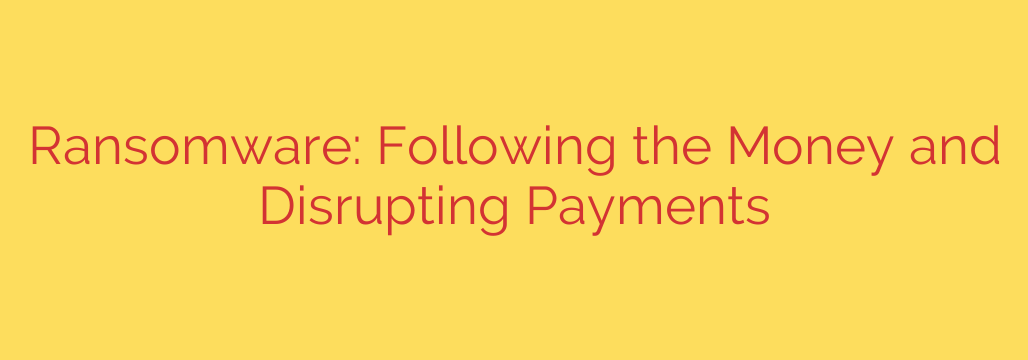
Follow the Money: The Battle to Disrupt the Ransomware Payment Ecosystem
Ransomware has evolved from a niche technical threat into a multi-billion dollar criminal industry. It cripples hospitals, shuts down schools, and halts critical infrastructure, all driven by a single motive: profit. For years, the cybersecurity focus has been on prevention and defense. But a new, crucial front has opened in this fight—one that targets the financial lifeline of these criminal enterprises. By following the money and disrupting their payment systems, we can attack ransomware at its core.
Understanding this threat requires seeing it not just as malware, but as a sophisticated business model. Ransomware is a highly organized, profit-driven enterprise with a clear, repeatable process: gain access to a network, encrypt critical data, exfiltrate sensitive files, and issue a demand for payment. This entire operation, however, hinges on one critical component: the ability to get paid.
The Role of Cryptocurrency in Ransomware Attacks
The explosion of ransomware corresponds directly with the rise of cryptocurrencies. Before digital currencies, demanding large, untraceable payments from victims across the globe was a logistical nightmare for criminals. Today, it’s frighteningly simple.
Cybercriminals overwhelmingly demand payment in cryptocurrencies like Bitcoin (BTC) and Monero (XMR) for several key reasons:
- Speed and Accessibility: Transactions can be completed in minutes from anywhere in the world, bypassing traditional banking systems and regulations.
- Perceived Anonymity: While transactions on many blockchains are public, they are pseudonymous, tied to wallet addresses rather than real-world identities.
- Decentralization: There is no central authority that can easily freeze or reverse a transaction once it has been confirmed.
Cryptocurrencies provide the financial rails that make the modern ransomware business model possible. Without a reliable way to collect and launder funds, the incentive for these large-scale attacks would dramatically decrease.
Following the Money: The Complex Task of Tracing Ransom Payments
While cryptocurrency offers advantages to criminals, it also creates a digital breadcrumb trail. Every transaction on a public blockchain like Bitcoin’s is recorded on an immutable public ledger. This has given rise to the field of blockchain analysis, where experts trace the flow of illicit funds.
However, attackers are well aware of this and employ sophisticated techniques to hide their tracks and launder the proceeds. These methods include:
- Cryptocurrency Mixers (or Tumblers): These services pool funds from many different users and mix them together, making it extremely difficult to connect the incoming “dirty” crypto with the outgoing “clean” crypto.
- Chain Hopping: Attackers rapidly convert funds between different types of cryptocurrencies (e.g., Bitcoin to Monero and back to Bitcoin) across multiple exchanges to break the chain of custody.
- Unregulated Exchanges: Many threat actors use exchanges based in jurisdictions with lax anti-money laundering (AML) and know-your-customer (KYC) regulations, allowing them to cash out with minimal scrutiny.
Cybercriminals use sophisticated techniques like crypto mixers and chain hopping to launder ransom payments and obscure their origins. Tracing these funds requires a combination of advanced technology and deep investigative expertise.
A New Strategy: How to Disrupt the Ransomware Payment Pipeline
Recognizing that prevention alone is not enough, law enforcement and cybersecurity firms are increasingly focused on disrupting this financial ecosystem. This proactive strategy involves several key pillars:
- Public-Private Partnerships: Government agencies like the FBI are collaborating more closely than ever with private blockchain analysis firms. These firms have the specialized tools and talent to trace complex transactions in real-time, providing law enforcement with the intelligence needed to act.
- Targeted Sanctions: Governments are now imposing sanctions on cryptocurrency exchanges, mixers, and other financial services known to facilitate money laundering for ransomware groups. This makes it harder for criminals to convert their digital assets into traditional currency.
- Seizing Funds: In several high-profile cases, authorities have successfully seized cryptocurrency wallets containing millions of dollars in ransom payments, sometimes even recovering funds for victims. These actions send a clear message that crypto is not a financial safe haven for criminals.
A multi-faceted approach involving public-private partnerships, advanced blockchain analysis, and targeted sanctions is crucial to dismantling the financial infrastructure of ransomware groups. By making it harder and riskier for them to profit, we de-incentivize the entire criminal operation.
Protecting Your Business: Key Steps to Mitigate Ransomware Risk
While the industry fights ransomware on a macro level, every organization must take steps to protect itself. Focusing on foundational cybersecurity hygiene is the most effective way to avoid becoming a victim.
Here are essential, actionable steps to take today:
- Implement Multi-Factor Authentication (MFA): This is one of the single most effective controls to prevent unauthorized access to your accounts and systems.
- Maintain and Test Backups: Regularly back up your critical data and, just as importantly, test your ability to restore from those backups. Ensure backups are stored offline or on a separate network so they cannot be encrypted during an attack.
- Conduct Regular Security Training: Your employees are your first line of defense. Train them to recognize phishing emails, suspicious links, and other social engineering tactics.
- Patch and Update Systems Promptly: Attackers frequently exploit known vulnerabilities in software. A robust patch management program closes these easy entry points.
- Develop an Incident Response Plan: Know exactly what to do the moment you suspect an attack. This plan should include who to contact, how to isolate affected systems, and how to communicate with stakeholders. Having a robust, tested Incident Response Plan is non-negotiable for any modern organization.
Ultimately, the war on ransomware is being fought on two fronts: defending networks and dismantling the financial engines that power the attacks. By understanding how these criminals profit, we can better position ourselves to disrupt their operations and protect our most critical data.
Source: https://heimdalsecurity.com/blog/where-ransomware-profits-go-how-stop/








